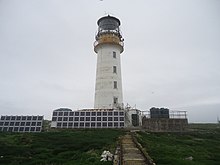geo.wikisort.org - Island
Sule Skerry is a remote skerry in the North Atlantic off the north coast of Scotland.
| Location | |
|---|---|
| OS grid reference | HX621244 |
| Coordinates | 59.08°N 4.41°W |
| Physical geography | |
| Island group | North Atlantic |
| Area | 16 ha (40 acres) |
| Highest elevation | 12 m (39 ft) |
| Administration | |
| Sovereign state | United Kingdom |
| Country | Scotland |
| Council area | Orkney |
| Demographics | |
| Population | 0 |
| References | [1][2][3] |
| Sule Skerry Lighthouse | |
 | |
| Coordinates | 59.084713°N 4.407325°W |
| Constructed | 1895 |
| Built by | David Alan Stevenson, Charles Alexander Stevenson |
| Construction | masonry tower |
| Automated | 1982 |
| Height | 27 m (89 ft) |
| Shape | cylindrical tower with balcony and lantern |
| Markings | white tower, black lantern, ochre trim |
| Power source | solar power |
| Operator | Northern Lighthouse Board[4][5] |
| Heritage | category A listed building |
| Focal height | 34 m (112 ft) |
| Lens | "hyperradiant" Fresnel lens |
| Range | 21 nmi (39 km) |
| Characteristic | Fl (2) W 15 s |
Geography
Sule Skerry lies 60 kilometres (32 nautical miles) west of the Orkney Mainland at grid reference HX621244. Sule Skerry's sole neighbour, Sule Stack, lies 10 km (5+1⁄2 nmi) to the southwest; the remote islands of Rona and Sula Sgeir lie approximately 80 km (45 nmi) further west. Sule Skerry and Sule Stack are both a part of the Orkney Islands council area.
Sule Skerry is 16 hectares (40 acres) in area and about 800 m (1⁄2 mi) long.[6] It reaches a height of 12 metres (40 feet).[7] It is formed of Lewisian gneiss.[8]
Biology
Sule Skerry together with Sule Stack are listed as a Special Protection Area as they are home during the breeding season to thousands of puffins and gannets and smaller numbers of the rarer Leach's storm petrel and storm petrels. Note that Leach's petrel visit the island but breeding is not proved. Since the first visiting birds in 2003 there is now a large breeding population of gannets; a possible overflow from nearby Sule Stack.
Every three years the puffins and other seabirds on Sule Skerry are monitored by a team of birders called the Sule Skerry Ringing Group. They have been monitoring the seabirds on the island since 1975.
The island is treeless, since few trees would withstand the high winds of winter and salt spray environment. The dominant plant is maritime mayweed (Tripleurospermum maritimum).
Lighthouse


There is a lighthouse at the centre high point of the island and a number of small cairns around the periphery. According to the Guinness Book of Records, the Sule Skerry lighthouse was the most remote manned lighthouse in Great Britain from its opening in 1895 to its automation in 1982. Its remote location meant that construction could only take place during the summer, thus it took from 1892–94 to complete.
A meteorological buoy used in Met Office's Marine Automatic Weather Station (MAWS) Network is located off Sule Skerry. Results from the buoy are used in the Shipping Forecast.
Folklore
"The Great Silkie of Sule Skerry" is a story of a Silkie who lives on Sule Skerry.
See also
- List of islands in Scotland
- List of lighthouses in Scotland
- List of Northern Lighthouse Board lighthouses
- List of outlying islands of Scotland
References
- National Records of Scotland (15 August 2013). "Appendix 2: Population and households on Scotland's Inhabited Islands" (PDF). Statistical Bulletin: 2011 Census: First Results on Population and Household Estimates for Scotland Release 1C (Part Two) (PDF) (Report). SG/2013/126. Retrieved 14 August 2020.
- Haswell-Smith, Hamish (2004). The Scottish Islands. Edinburgh: Canongate. ISBN 978-1-84195-454-7.
- Ordnance Survey: Landranger map sheet 6 Orkney (Mainland) (Map). Ordnance Survey. 2014. ISBN 9780319228128.
- Rowlett, Russ. "Lighthouses of Scotland: Orkney". The Lighthouse Directory. University of North Carolina at Chapel Hill. Retrieved 12 May 2016.
- Sule Skerry Northern Lighthouse Board. Retrieved 12 May 2016
- SPA description
- National Geospatial-Intelligence Agency: Sailing Directions (Enroute), Pub. 141, Scotland.
- Kirton, S.R.; Hitchen, K. (1987). "Timing and style of crustal extension N of the Scottish mainland". In Coward M.P., Dewey J.F. & Hancock P.L. (ed.). Continental Extensional Tectonics. Special Publications. Vol. 28. London: Geological Society. pp. 501–510. ISBN 978-0-632-01605-1.
External links
На других языках
[de] Sule Skerry
Sule Skerry ist eine flache, grasbewachsene und unbewohnte nordatlantische Insel im Westen der schottischen Orkneyinseln. Die Insel weist eine Fläche von 16 Hektar auf, und erreicht eine Höhe von 12 Metern.- [en] Sule Skerry
[fr] Sule Skerry
Sule Skerry est une île du Royaume-Uni située au large des principales îles de l'archipel des Orcades en Écosse.[ru] Сул-Скерри
Сул-Скерри (англ. Sule Skerry) — удаленный необитаемый остров на севере Шотландии. Он сложен, как и его сосед, Стак-Скерри (Сул-Стак), льюисовыми гнейсами, имеет протяженность в 800 м и расположен в 60 км к западу от Оркнейских островов и 80 км к востоку от Северной Роны. Вместе с Сул-Стак, лежащим в 10 км к юго-западу, является охраняемым районом, поскольку на островах гнездятся тысячи бакланов и атлантических тупиков, а также северных качурок. Птицы ежегодно наблюдаются командой орнитологов.Другой контент может иметь иную лицензию. Перед использованием материалов сайта WikiSort.org внимательно изучите правила лицензирования конкретных элементов наполнения сайта.
WikiSort.org - проект по пересортировке и дополнению контента Википедии
